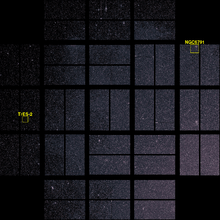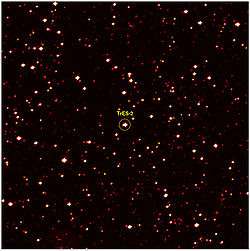GSC 03549-02811
| Observation data Epoch J2000.0 Equinox J2000.0 | |
|---|---|
| Constellation | Draco |
| A | |
| Right ascension | 19h 07m 14.035s[1] |
| Declination | +49° 18′ 59.07″[1] |
| Apparent magnitude (V) | 11.41 |
| B | |
| Right ascension | ~19h 07m 14s[2] |
| Declination | ~+49° 18′ 59″[2] |
| Apparent magnitude (V) | 14.73[2] |
| Characteristics | |
| Spectral type | G0V[1]/K[2] |
| Apparent magnitude (B) | ~12.030[1] |
| Apparent magnitude (V) | 11.411±0.005[1] |
| Apparent magnitude (J) | 10.232±0.020[1] |
| Apparent magnitude (H) | 9.920±0.026[1] |
| Apparent magnitude (K) | 9.846±0.022[1] |
| Astrometry | |
| Proper motion (μ) | RA: 2.9[1] mas/yr Dec.: -3.4[1] mas/yr |
| Distance | 718±33 ly (220±10 pc) |
| Details | |
| Mass | 1.05[2]/0.67[2] M☉ |
| Radius | 1.000+0.036 −0.033[3] R☉ |
| Temperature | 5850±50[3] K |
| Metallicity | −0.15±0.1[3] |
| Age | 5.1+2.7 −2.3×109[3] years |
| Other designations | |
| Database references | |
| SIMBAD | data |
| Extrasolar Planets Encyclopaedia | data |
GSC 03549-02811 A (referred to as TrES-2 or TrES-2 A in reference to its exoplanet, also known as Kepler-1)[4] is a yellow main-sequence star similar to our Sun. This star is located approximately 718 light-years away in the constellation of Draco. The apparent magnitude of this star is 11.41, which means it is not visible to the naked eye but can be seen with a medium-sized amateur telescope on a clear dark night. The age of this star is about 5 billion years.[1]
Planetary system
In 2006 the exoplanet TrES-2b was discovered by the TrES program using the transit method. It is also within the field of view of the previously operational Kepler Mission planet-hunter spacecraft.[5] This system continues to be studied by other projects and the parameters are continuously improved.[3] The planet orbits the primary star.[2]
| Companion (in order from star) |
Mass | Semimajor axis (AU) |
Orbital period (days) |
Eccentricity | Inclination | Radius |
|---|---|---|---|---|---|---|
| TrES-2b | 1.199±0.052[2] MJ | 0.03556±0.00075[2] | 2.47063±0.00001[5] | 0 | — | 1.272 RJ |
Though TrES-2b is currently the darkest known exoplanet, reflecting less than 1 percent of local sunlight, it does show a faint red glow. This is because its surface is a punishing 1,100°C, so hot that it actually glows red. It is assumed to be tidally locked to its parent star.[6]
Binary star
In 2008 a study was undertaken of fourteen stars with exoplanets that were originally discovered using the transit method through relatively small telescopes. These systems were re-examined with the 2.2M reflector telescope at the Calar Alto Observatory in Spain. This star system, along with two others, was determined to be a previously unknown binary star system. The previously unknown secondary star is a dim magnitude 15 K-type star separated by about 232 AU from the primary, appearing offset from the primary by about one arc second in the images. This discovery resulted in a significant recalculation of parameters for both the planet and the primary star.[2]
The Kepler Mission

In March 2009 NASA launched the Kepler Mission spacecraft. This spacecraft is a dedicated mission to discover extrasolar planets by the transit method from solar orbit. In April 2009 the project released the first light images from the spacecraft and TrES-2b was one of two objects highlighted in these images. Although TrES-2b is not the only known exoplanet in the field of view of this spacecraft it is the only one identified in the first-light images. This object is important for calibration and check-out.[7]
See also
References
- 1 2 3 4 5 6 7 8 9 10 11 12 "SIMBAD query result: NAME TrES-2 Parent Star -- Star". Centre de Données astronomiques de Strasbourg. Retrieved 2009-04-22.
- 1 2 3 4 5 6 7 8 9 10 Daemgen; Hormuth, F.; Brandner, W.; Bergfors, C.; Janson, M.; Hippler, S.; Henning, T. (2009). "Binarity of transit host stars — Implications for planetary parameters" (PDF). Astronomy and Astrophysics. 498 (2): 567–574. arXiv:0902.2179
 . Bibcode:2009A&A...498..567D. doi:10.1051/0004-6361/200810988.
. Bibcode:2009A&A...498..567D. doi:10.1051/0004-6361/200810988. - 1 2 3 4 5 Alessandro Sozzetti; Torres, Guillermo; Charbonneau, David; Latham, David W.; Holman, Matthew J.; Winn, Joshua N.; Laird, John B.; o’Donovan, Francis T. (August 1, 2007). "Improving Stellar and Planetary Parameters of Transiting Planet Systems: The Case of TrES-2". The Astrophysical Journal. 664 (2): 1190–1198. arXiv:0704.2938
 . Bibcode:2007ApJ...664.1190S. doi:10.1086/519214.
. Bibcode:2007ApJ...664.1190S. doi:10.1086/519214. - ↑ D. Mislis; S. Schroter; J.H.M.M. Schmitt; O. Cordes; K. Reif (December 2009). "Multi-band transit observations of the TrES-2b exoplanet". arXiv:0912.4428v1
 [astro-ph.EP].
[astro-ph.EP]. - 1 2 O'Donovan; Charbonneau, David; Mandushev, Georgi; Dunham, Edward W.; Latham, David W.; Torres, Guillermo; Sozzetti, Alessandro; Brown, Timothy M.; et al. (October 16, 2006). "TrES-2: The First Transiting Planet in the Kepler Field". The Astrophysical Journal Letters. 651 (1): L61–L64. arXiv:astro-ph/0609335
 . Bibcode:2006ApJ...651L..61O. doi:10.1086/509123.
. Bibcode:2006ApJ...651L..61O. doi:10.1086/509123. - ↑ http://news.yahoo.com/coal-black-alien-planet-darkest-ever-seen-220601419.html
- ↑ "Kepler Eyes Cluster and Known Planet". NASA. 2009-04-16. Retrieved 2009-05-09.
External links
- "Host to 'Hot Jupiter' (labeled)". multimedia/images. NASA. 2009-04-16. Retrieved 2009-04-28.
- "TrES-2". Exoplanets. Retrieved 2009-04-28.
Coordinates: ![]() 19h 07m 14s, +49° 18′ 59″
19h 07m 14s, +49° 18′ 59″
